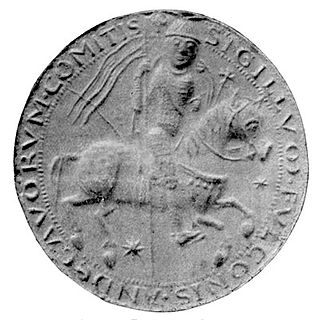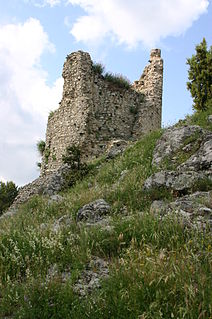
The 12th century is the period from 1101 to 1200 in accordance with the Julian calendar. In the history of European culture, this period is considered part of the High Middle Ages and is sometimes called the Age of the Cistercians. The Golden Age of Islam experienced a significant development, particularly in Islamic Spain.

Year 1154 (MCLIV) was a common year starting on Friday of the Julian calendar.

Year 1143 (MCXLIII) was a common year starting on Friday of the Julian calendar.

Roger II was King of Sicily and Africa, son of Roger I of Sicily and successor to his brother Simon. He began his rule as Count of Sicily in 1105, became Duke of Apulia and Calabria in 1127, then King of Sicily in 1130 and King of Africa in 1148. By the time of his death at the age of 58, Roger had succeeded in uniting all the Norman conquests in Italy into one kingdom with a strong centralized government.

Robert Guiscard was a Norman adventurer remembered for the conquest of southern Italy and Sicily. Robert was born into the Hauteville family in Normandy, went on to become count and then duke of Apulia and Calabria (1057–1059), duke of Sicily (1059–1085), and briefly prince of Benevento (1078–1081) before returning the title to the papacy.

Roger I, nicknamed Roger Bosso and The Great, was a Norman nobleman who became the first Count of Sicily from 1071 to 1101. He was a member of the House of Hauteville, and his descendants in the male line continued to rule Sicily down to 1194.

The Battle of Civitate was fought on 18 June 1053 in southern Italy, between the Normans, led by the Count of Apulia Humphrey of Hauteville, and a Swabian-Italian-Lombard army, organised by Pope Leo IX and led on the battlefield by Gerard, Duke of Lorraine, and Rudolf, Prince of Benevento. The Norman victory over the allied papal army marked the climax of a conflict between the Norman mercenaries who came to southern Italy in the eleventh century, the de Hauteville family, and the local Lombard princes. By 1059 the Normans would create an alliance with the papacy, which included a formal recognition by Pope Nicholas II of the Norman conquest in south Italy, investing Robert Guiscard as Duke of Apulia and Calabria, and Count of Sicily.
Humphrey of Hauteville, surnamed Abagelard, was the Count of Apulia and Calabria from 1051 to his death.
Richard Drengot was the count of Aversa (1049–1078), prince of Capua and duke of Gaeta (1064–1078).

Alfonso, also called Anfuso or Anfusus, was the Prince of Capua from 1135 and Duke of Naples from 1139. He was an Italian-born Norman of the noble Hauteville family. After 1130, when his father Roger became King of Sicily, he was the third in line to the throne; second in line after the death of an older brother in 1138. He was the first Hauteville prince of Capua after his father conquered the principality from the rival Norman Drengot family. He was also the first Norman duke of Naples after the duchy fell vacant on the death of the last Greek duke. He also expanded his family's power northwards, claiming lands also claimed by the Papacy, although he was technically a vassal of the Pope for his principality of Capua.
Geoffrey of Hauteville was a Norman military leader, the second youngest son of Tancred of Hauteville by his first wife Muriella. He joined his brothers in the Mezzogiorno around 1053, arriving with his half-brothers Mauger and William. He was certainly present at the Battle of Civitate in that year.
Robert I was an Italo-Norman nobleman, the eldest son of Geoffrey of Hauteville, one of the elder sons of Tancred of Hauteville. He was the first count of Loritello in 1061.

The Hauteville was a Norman family originally of seigneurial rank from the Cotentin. The Hautevilles rose to prominence through their part in the Norman conquest of southern Italy. By 1130, one of their members, Roger II, was made the first King of Sicily. His male-line descendants ruled Sicily until 1194. Some Italian Hautevilles took part in the First Crusade and the founding of the Principality of Antioch (1098).
The Drengots were a Norman family of mercenaries, one of the first to head to the Mezzogiorno of Italy to fight in the service of the Lombards. They became the most prominent family after the Hautevilles.
The Principality of Capua was a Lombard state centred on Capua in Southern Italy, usually de facto independent, but under the varying suzerainty of Holy Roman and Eastern Roman Empires. It was originally a gastaldate, then a county, within the principality of Salerno.

The Norman conquest of southern Italy lasted from 999 to 1139, involving many battles and independent conquerors.

The County of Apulia and Calabria, later the Duchy of Apulia and Calabria, was a Norman state founded by William of Hauteville in 1042 in the territories of Gargano, Capitanata, Apulia, Vulture, and most of Campania. It became a duchy when Robert Guiscard was raised to the rank of duke by Pope Nicholas II in 1059.
Maud of Apulia was a member of the Norman D’Hauteville family and a daughter of Robert Guiscard and his second wife Sikelgaita, a Lombard princess, the daughter of Guaimar IV, Prince of Salerno. She was also known as Mahalda, Mahault, Mafalda and Matilda. She was the wife of Ramón Berenguer II, and thus Countess of Barcelona (1078–1082). After her husband’s death, she remarried Aimery I, the Viscount of Narbonne (1086–1108).

Clementia was the countess of Catanzaro in the Kingdom of Sicily. She played a major role in the baronial rebellion of 1160–62.